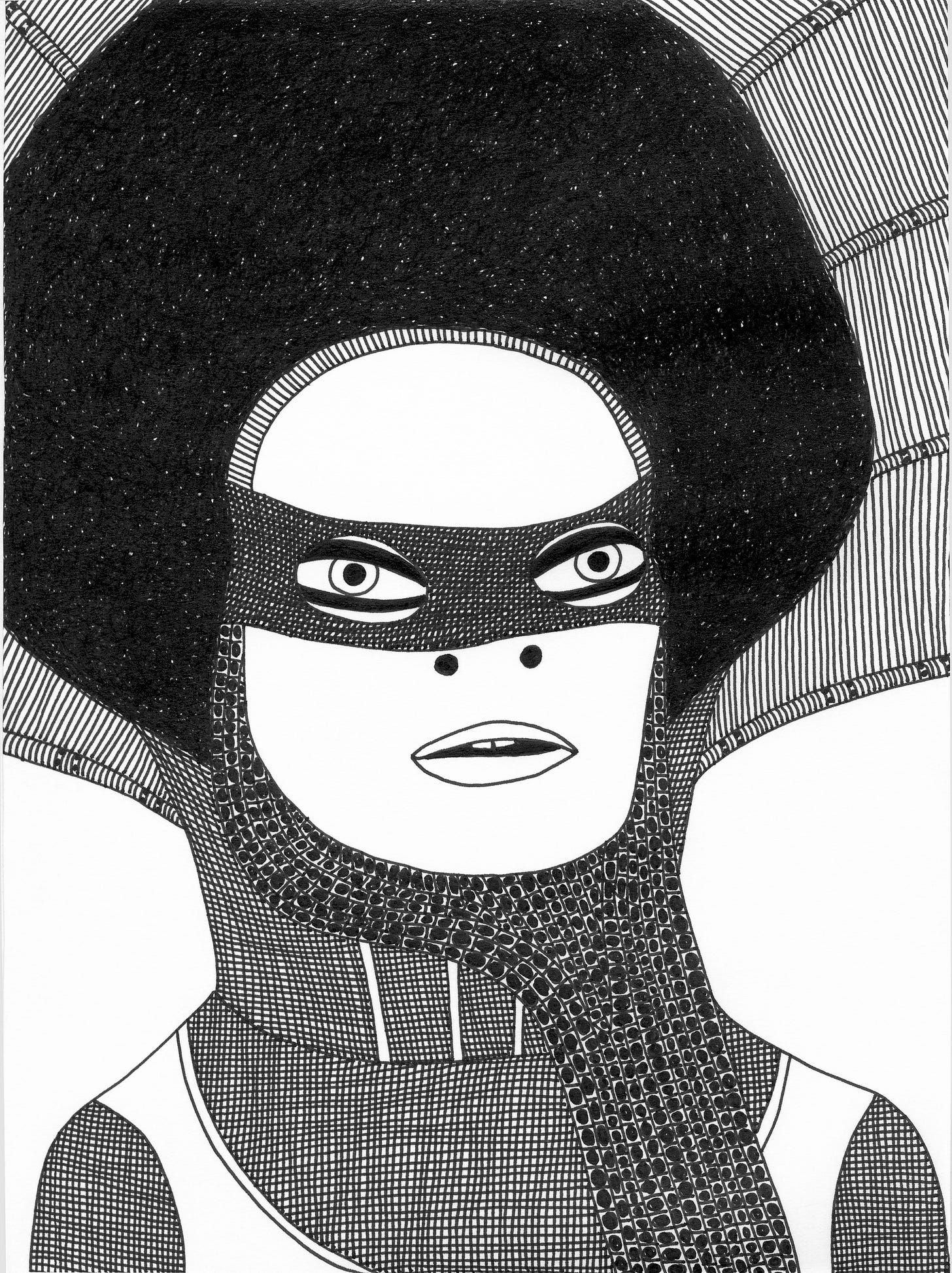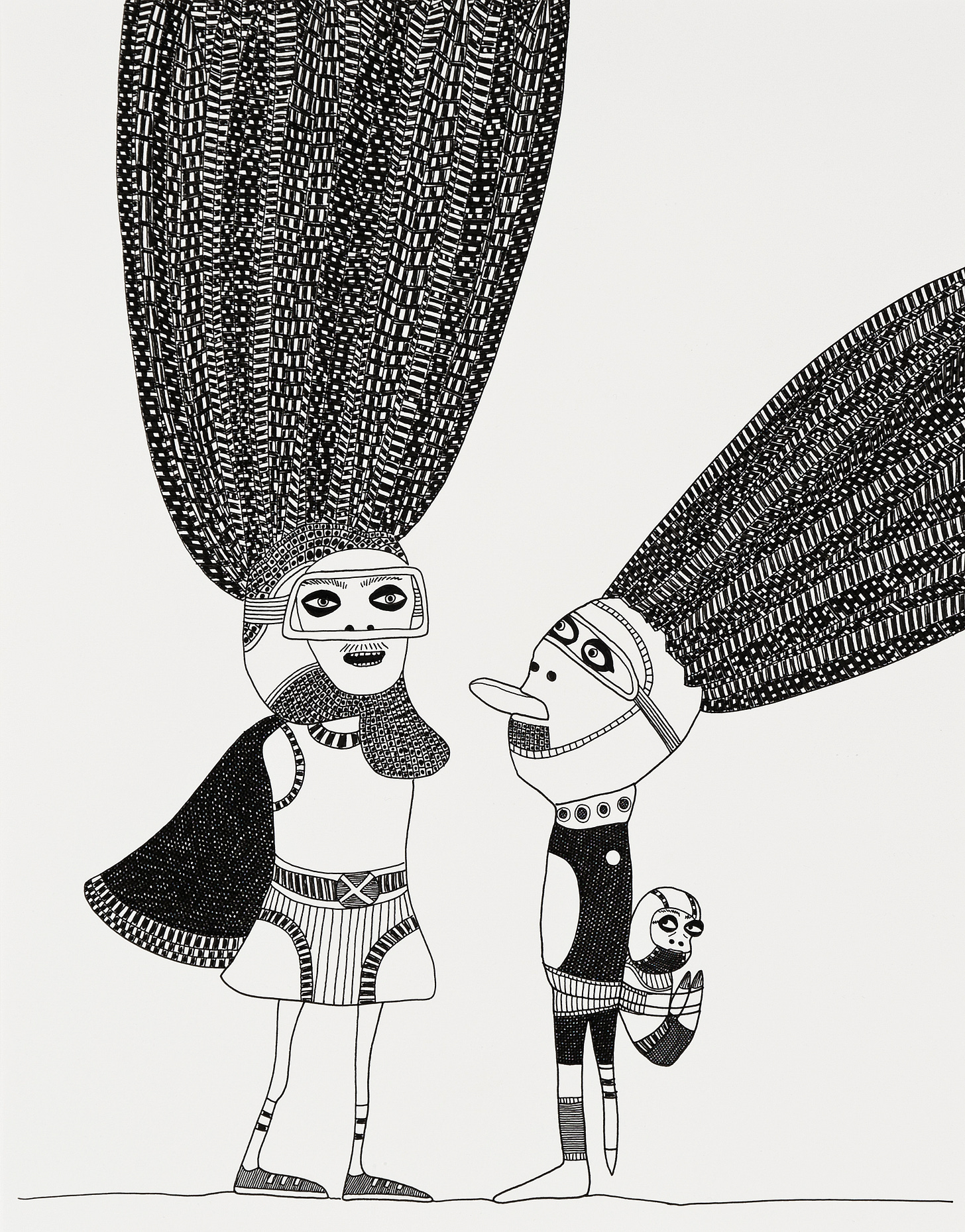Review: Is anything the matter? Drawings by Laylah Ali
Is anything the matter? Drawings by Laylah Ali University Museum of Contemporary Art, University of Massachusetts Amherst February 14 to May 9, 2025
As I stepped into the main gallery of the University Museum of Contemporary Art (UMCA), I was confronted with the question—Is anything the matter?—splayed across the entry wall. Instinctively, my mind responded: Yes—everything is the matter. Each day, amid the quiet urgencies that press against our daily lives, we are bombarded with the news that our world is burning, both literally and figuratively. This question, at once casual and existential, feels less like a mere inquiry and more like an invitation—one that sets the tone for what lies ahead.

This February, the UMCA at UMass Amherst became the second stop in the touring retrospective Is Anything the Matter? Drawings by Laylah Ali, which showcases Ali’s works from 1993 to 2020. Following an initial run at the Cathy and Jesse Marion Art Gallery at SUNY Fredonia, UMCA currently showcases over one hundred of Ali’s drawings in its Main and West Galleries. The exhibition tour will conclude at the Colby College Museum of Art in Waterville, Maine.
Ali’s drawings, rendered in ink, colored pencil, soluble crayon, marker, or mixed media and often unsettling in their precision and restraint, operate in what Karen Kurczynski describes as a “quiet confrontation”—a space where the familiar becomes strange and meaning is never fully settled.1 Ali’s drawings are at once uncanny and unearthly, serving as meditations on what she describes as “the amalgam of race, power, gendering, human frailty, murky politics, and other complex combinations that are so often treated as separate entities.”2
While all of Ali’s work resists easy interpretation, certain moments in the exhibition are particularly potent, offering glimpses into the complexity, humor, and quiet violence embedded in her practice. One such moment emerges in her Superman drawings (2000), an early precursor to her Greenheads Series. These works depict androgynous figures with green heads, brown hands, and black masks, each draped in a signature red cape. In one drawing, two caped figures, both grimacing as they fly through the sky, engage in a terse exchange. Depicted in a speech bubble, one figure says, “You are the only one with a clear-headed vision of the future.” The other, looking perturbed, simply responds: “Stop.” Ali’s Superman drawings borrow from the visual language of comics yet destabilize the superhero mythos. Instead of embodying confidence, power, and certainty, her figures appear burdened, awkward, and slightly absurd. Their dialogue, almost comically brief, carries a deeper tension. What does it mean to be labeled the visionary? To bear the weight of foresight? Ali’s use of humor here is subtle—she dissects the archetype of the hero, exposing the expectation that certain individuals must lead, prophesize, or save. Yet her figures resist this role, rejecting the assumption that clarity is always a gift rather than a burden.
Another striking moment in the exhibition is Self-Portraits with Nat Turner’s Vision, one of Ali’s earliest series, consisting of twenty-one small ink drawings on paper. In these works, she positions her own image in relation to Nat Turner, the enslaved preacher whose divine visions convinced him to lead what became one of the first and arguably most successful slave rebellions in U.S. history.

Ali interrogates the gendering of vision and deliberately blurs the boundaries between herself and Turner, depicting figures that shift between male, androgynous, and non-binary forms. In many scenes, it is unclear who is Ali and who is Turner, compelling viewers to hold open multiple possibilities. This ambiguity challenges us to consider what it means to be called to a revolutionary vision. Reflecting on this tension, Ali notes, “In the Self-Portraits with Nat Turner’s Vision drawings, I was exploring how this kind of vision, which is often violent in nature and has the goal to change the course of history, has been usually presented as primarily gendered male in its drive and focus. Among other things, the drawings contained some longing for that certainty of vision, but also with the knowledge that it was also absurd of me to do so. Perhaps even more than that, I resisted that certainty.”3 These drawings do not function as declarations of prophecy but rather as acts of witnessing, exploring how the past inhabits the present and how we position ourselves within its weight.
Unlike a fixed retrospective, Is Anything the Matter? is a living exhibition, evolving with each venue. This is a reflective practice for Ali as she herself takes on the role of curator, selecting and arranging the works to suit each venue’s unique space.4This process disrupts the notion of a retrospective as a static look back, transforming it instead into an ongoing, site-specific dialogue. Rather than presenting her work as fixed, answered, and resolved, Ali approaches curation as an extension of her artistic practice—one that remains fluid and responsive.

This adaptability mirrors the nature of Ali’s drawings themselves, which, as she reflects in an interview with Romi Crawford, are her raw, unfiltered expressions of thought: “Looking through the drawings is different from reading through a journal because the drawings seem to cut right past sensible or logical self-presentation and go directly into the more raw and vulnerable questions I was having at any given time. The main surprise for me is how many drawings I come across that I have forgotten about.”5 This admission speaks to the intuitive, subconscious nature of her drawing process—one that resists polish or resolution in favor of spontaneity and exploration. By curating her own retrospective, Ali engages in a similar process of rediscovery, unearthing past works and recontextualizing them in new environments and moments.
The result is an exhibition that is not merely about looking back but about re-seeing, an encountering with Ali’s drawings in ways that shift with time, space, and audience. Each iteration of Is Anything the Matter? becomes an experiment in witnessing where forgotten or overlooked works take on new resonance and urgency depending on where and how they are shown. In this way, Ali extends the life of her drawings beyond their initial creation, allowing them to continue questioning, unsettling, and demanding engagement long after they leave her hands.

The exhibition title itself lingers. Is Anything the Matter? is both a question and a statement, a provocation and a plea. Ali never provides a clear answer, and that is precisely the point. Her work is not about resolution but about sustaining tension, sitting with discomfort, and acknowledging the complexity of what remains unseen and needs to be worked through. In the end, we leave the exhibition with more questions than answers, haunted by the figures who refuse to be fully known. Ali’s work demands that we stay with these questions. That we look closer.
OLIVIA HAYNES is a Ph.D. candidate in the W.E.B. Du Bois Department of Afro-American Studies at the University of Massachusetts Amherst, where she has also completed a graduate certificate in Public History. Her research focuses on the history of slavery, with an emphasis on the visual and material culture of slavery, social reproduction theory, and Black motherhood. Her dissertation project examines Black women’s birthwork and birthing practices in the eighteenth and nineteenth-century US North.
Notes
1 Karen Kurczynski, “Power in Play: The Drawings of Laylah Ali,” in Is anything the matter? Drawings by Laylah Ali (Fredonia: Cathy and Jesse Marion Art Gallery, 2024), 9.
2 “Exhibition to feature drawings by award-winning artist” Observer, January 19, 2024.
3 Romi Crawford, “Are you one of them? An Interview with Laylah Ali” in Is anything the matter? Drawings by Laylah Ali, 42.
4 “Laylah Ali Is Back In WNY: Marion Art Gallery surveys the renowned artist’s work,” Buffalo Spree January/February 2024.
5 Crawford, “Are you one of them? An Interview with Laylah Ali,” 41.



